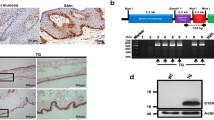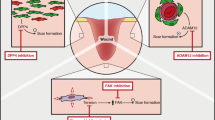Abstract
Background
Bone morphogenetic proteins (BMPs) and their receptors (BMPRs) play roles in embryonic development and postnatal remodelling of the skin. Many indications suggest that BMP signalling regulates keratinocyte proliferation and differentiation. Chronic wounds have been shown to exhibit high levels of BMP ligands; however, the effect of BMP pathway modulation on human skin healing remains undefined.
Methods
A human ex vivo skin wound healing model was used to analyse the expression of BMP signalling pathway components during healing and to investigate the effects of BMPs and the BMP antagonist Noggin on skin repair. Additionally, the effects of BMP signalling on keratinocyte proliferation, apoptosis and migration were tested using in vitro flow cytometry and ‘scratch’ migration assays, respectively.
Results
BMP receptor-1B (BMPR-1B) and downstream signalling protein phosphorylated-Smad-1/5/8 were highly expressed in healing epidermis. Treatment of human skin with exogenous BMPs impaired wound closure by reducing keratinocyte proliferation and increasing apoptosis. The BMP antagonist Noggin negated the inhibitory effects of BMP ligands, and when used alone, Noggin reduced keratinocyte apoptosis in the wound bed. In vitro, BMP ligands suppressed keratinocyte proliferation whilst Noggin stimulated proliferation. Keratinocyte migration was slowed following BMP treatment; in contrast, migration was significantly accelerated due to inhibition of BMP activity by either Noggin or BMPR-1B silencing.
Conclusions
BMP signalling is inherently involved in wound healing. BMPs slow skin repair by suppressing keratinocyte proliferation and migration. Thus, modulation of BMP signalling using BMP inhibitors such as Noggin may serve as a new approach to promote cutaneous wound repair.
Level of evidence: Not ratable.







Similar content being viewed by others
References
Hay E, Lemonnier J, Fromigue O et al (2004) Bone morphogenetic protein receptor IB signaling mediates apoptosis independently of differentiation in osteoblastic cells. J Biol Chem 279:1650–8
Botchkarev VA (2003) Bone morphogenetic proteins and their antagonists in skin and hair follicle biology. J Investig Dermatol 120:36–47
Botchkarev VA, Sharov AA (2004) BMP signaling in the control of skin development and hair follicle growth. Differentiation 72:512–26
Massague J (1998) TGF-beta signal transduction. Annu Rev Biochem 67:753–91
Botchkarev VA, Botchkareva NV, Roth W et al (1999) Noggin is a mesenchymally derived stimulator of hair-follicle induction. Nat Cell Biol 1:158–64
Botchkarev VA, Botchkareva NV, Nakamura M et al (2001) Noggin is required for induction of the hair follicle growth phase in postnatal skin. FASEB J 15:2205–14
Sharov AA, Sharova TY, Mardaryev AN et al (2006) Bone morphogenetic protein signaling regulates the size of hair follicles and modulates the expression of cell cycle-associated genes. Proc Natl Acad Sci U S A 103:18166–71
Kinsella CR Jr, Cray JJ, Durham EL et al (2011) Recombinant human bone morphogenetic protein-2-induced craniosynostosis and growth restriction in the immature skeleton. Plast Reconstr Surg 127:1173–81
Miyazono K, Maeda S, Imamura T (2005) BMP receptor signaling: transcriptional targets, regulation of signals, and signaling cross-talk. Cytokine Growth Factor Rev 16:251–63
Massague J, Chen YG (2000) Controlling TGF-beta signaling. Genes Dev 14:627–44
Hwang EA, Lee HB, Tark KC (2001) Comparison of bone morphogenetic protein receptors expression in the fetal and adult skin. Yonsei Med J 42:581–6
Kobielak K, Pasolli HA, Alonso L et al (2003) Defining BMP functions in the hair follicle by conditional ablation of BMP receptor IA. J Cell Biol 163:609–23
Andl T, Ahn K, Kairo A et al (2004) Epithelial Bmpr1a regulates differentiation and proliferation in postnatal hair follicles and is essential for tooth development. Development 131:2257–68
Ming Kwan K, Li AG, Wang XJ et al (2004) Essential roles of BMPR-IA signaling in differentiation and growth of hair follicles and in skin tumorigenesis. Genesis 39:10–25
Sharov AA, Fessing M, Atoyan R et al (2005) Bone morphogenetic protein (BMP) signaling controls hair pigmentation by means of cross-talk with the melanocortin receptor-1 pathway. Proc Natl Acad Sci U S A 102:93–8
Kobielak K, Stokes N, de la Cruz J et al (2007) Loss of a quiescent niche but not follicle stem cells in the absence of bone morphogenetic protein signaling. Proc Natl Acad Sci U S A 104:10063–8
Spector JA, Luchs JS, Mehrara BJ et al (2001) Expression of bone morphogenetic proteins during membranous bone healing. Plast Reconstr Surg 107:124–34
Bostrom MP (1998) Expression of bone morphogenetic proteins in fracture healing. Clin Orthop Relat Res:S116-23
Garrison KR, Shemilt I, Donell S, et al. (2010) Bone morphogenetic protein (BMP) for fracture healing in adults. Cochrane Database Syst Rev:CD006950
Kaiser S, Schirmacher P, Philipp A et al (1998) Induction of bone morphogenetic protein-6 in skin wounds. Delayed reepitheliazation and scar formation in BMP-6 overexpressing transgenic mice. J Investig Dermatol 111:1145–52
Lewis CJ, Mardaryev AN, Poterlowicz K et al (2014) Bone morphogenetic protein signaling suppresses wound-induced skin repair by inhibiting keratinocyte proliferation and migration. J Investig Dermatol 134:827–37
Rizzo AE, Beckett LA, Baier BS et al (2012) The linear excisional wound: an improved model for human ex vivo wound epithelialization studies. Skin Res Technol 18:125–32
Antsiferova M, Klatte JE, Bodo E et al (2009) Keratinocyte-derived follistatin regulates epidermal homeostasis and wound repair. Lab Investig 89:131–41
Bamberger C, Scharer A, Antsiferova M et al (2005) Activin controls skin morphogenesis and wound repair predominantly via stromal cells and in a concentration-dependent manner via keratinocytes. Am J Pathol 167:733–47
Desmouliere A, Redard M, Darby I et al (1995) Apoptosis mediates the decrease in cellularity during the transition between granulation tissue and scar. Am J Pathol 146:56–66
Boukamp P, Petrussevska RT, Breitkreutz D et al (1988) Normal keratinization in a spontaneously immortalized aneuploid human keratinocyte cell line. J Cell Biol 106:761–71
Douglas HE (2010) TGF-ss in wound healing: a review. J Wound Care 19:403–6
Kane CJ, Hebda PA, Mansbridge JN et al (1991) Direct evidence for spatial and temporal regulation of transforming growth factor beta 1 expression during cutaneous wound healing. J Cell Physiol 148:157–73
Yang L, Chan T, Demare J et al (2001) Healing of burn wounds in transgenic mice overexpressing transforming growth factor-beta 1 in the epidermis. Am J Pathol 159:2147–57
Wall NA, Blessing M, Wright CV et al (1993) Biosynthesis and in vivo localization of the decapentaplegic-Vg-related protein, DVR-6 (bone morphogenetic protein-6). J Cell Biol 120:493–502
Takahashi H, Ikeda T (1996) Transcripts for two members of the transforming growth factor-beta superfamily BMP-3 and BMP-7 are expressed in developing rat embryos. Dev Dyn 207:439–49
Mathura JR Jr, Jafari N, Chang JT et al (2000) Bone morphogenetic proteins-2 and -4: negative growth regulators in adult retinal pigmented epithelium. Invest Ophthalmol Vis Sci 41:592–600
Childs AJ, Kinnell HL, Collins CS et al (2010) BMP signaling in the human fetal ovary is developmentally regulated and promotes primordial germ cell apoptosis. Stem Cells 28:1368–78
Pi W, Guo X, Su L et al (2012) BMP-2 up-regulates PTEN expression and induces apoptosis of pulmonary artery smooth muscle cells under hypoxia. PLoS One 7:e35283
Zhang J, Ge Y, Sun L et al (2012) Effect of bone morphogenetic protein-2 on proliferation and apoptosis of gastric cancer cells. Int J Med Sci 9:184–92
Pardali K, Kowanetz M, Heldin CH et al (2005) Smad pathway-specific transcriptional regulation of the cell cycle inhibitor p21(WAF1/Cip1). J Cell Physiol 204:260–72
Plikus M, Wang WP, Liu J et al (2004) Morpho-regulation of ectodermal organs: integument pathology and phenotypic variations in K14-Noggin engineered mice through modulation of bone morphogenic protein pathway. Am J Pathol 164:1099–114
Krause C, Guzman A, Knaus P (2011) Noggin. Int J Biochem Cell Biol 43:478–81
Ahmed MI, Mardaryev AN, Lewis CJ et al (2011) MicroRNA-21 is an important downstream component of BMP signalling in epidermal keratinocytes. J Cell Sci 124:3399–404
Drozdoff V, Wall NA, Pledger WJ (1994) Expression and growth inhibitory effect of decapentaplegic Vg-related protein 6: evidence for a regulatory role in keratinocyte differentiation. Proc Natl Acad Sci U S A 91:5528–32
Jiang J, Zhang J, Wang X et al (2011) Effects of bone morphogenetic protein-2 on proliferation of tongue cancer Tca8113. Hua Xi Kou Qiang Yi Xue Za Zhi 29:546–9
Blessing M, Schirmacher P, Kaiser S (1996) Overexpression of bone morphogenetic protein-6 (BMP-6) in the epidermis of transgenic mice: inhibition or stimulation of proliferation depending on the pattern of transgene expression and formation of psoriatic lesions. J Cell Biol 135:227–39
Fessing MY, Atoyan R, Shander B et al (2010) BMP signaling induces cell-type-specific changes in gene expression programs of human keratinocytes and fibroblasts. J Investig Dermatol 130:398–404
Li J, Chen J, Kirsner R (2007) Pathophysiology of acute wound healing. Clin Dermatol 25:9–18
Gillan L, Matei D, Fishman DA et al (2002) Periostin secreted by epithelial ovarian carcinoma is a ligand for alpha(V)beta(3) and alpha(V)beta(5) integrins and promotes cell motility. Cancer Res 62:5358–64
Ethical declaration
This work conforms to the ethical standards set out in the Declaration of Helsinki and was approved by the local research ethics committee. All patients were provided with informed consent and provided written consent for the use of their discarded tissue.
Conflicts of interest
None.
Patient consent
Patients provided written consent for the use of their images.
Funding sources
This research is funded by the University of Bradford Plastic Surgery & Burns Unit Charity Fund.
Author information
Authors and Affiliations
Corresponding author
Rights and permissions
About this article
Cite this article
Lewis, C.J., Mardaryev, A., Sharpe, D. et al. Inhibition of bone morphogenetic protein signalling promotes wound healing in a human ex vivo model. Eur J Plast Surg 38, 1–12 (2015). https://doi.org/10.1007/s00238-014-1031-8
Received:
Accepted:
Published:
Issue Date:
DOI: https://doi.org/10.1007/s00238-014-1031-8




